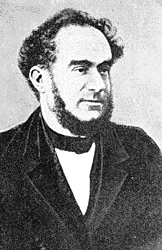Carlo Matteucci
This articleneeds additional citations forverification.(October 2022) |
Carlo Matteucci | |
|---|---|
 | |
| Born | 20 June 1811 |
| Died | 25 June 1868(aged 57) |
| Nationality | Italian |
| Alma mater | University of Bologna(PhD) (1829) |
| Known for | Matteucci effect |
| Awards | Copley Medal(1844) |
| Scientific career | |
| Fields | Physics Neurophysiology |
| Institutions | University of Pisa |
Carlo Matteucci(20 or 21 June 1811 – 25 June 1868) was an Italianphysicistandneurophysiologistwho was a pioneer in the study ofbioelectricity.
Biography[edit]
Carlo Matteucci was born atForlì,in the province ofRomagna,to Vincenzo Matteucci, a physician, and Chiara Folfi. He studied mathematics at theUniversity of Bolognafrom 1825 to 1828, receiving his doctorate in 1829.[1]From 1829 to 1831, he studied at theÉcole Polytechniquein Paris, France. Upon returning to Italy, Matteucci studied atBologna(1832),Florence,Ravenna(1837) andPisa.He established himself as the head of the laboratory of the Hospital of Ravenna and became a professor of physics at the local college. In 1840, by recommendation ofFrançois Arago(1786–1853), his teacher at the École Polytechnique, to the Grand-Duke ofTuscany,Matteucci accepted a post of professor ofphysicsat theUniversity of Pisa.
Instigated by the work ofLuigi Galvani(1737–1798) on bioelectricity, Matteucci began in 1830 a series of experiments which he pursued until his death in 1865. Using a sensitivegalvanometerofLeopoldo Nobili,he was able to prove that injured excitable biological tissues generated directelectrical currents,and that they could be summed up by adding elements in series, like inAlessandro Volta’s (1745-1827)electric pile.Thus, Mateucci was able to develop what he called a "rheoscopic frog",by using the cutnerveof a frog's leg and its attachedmuscleas a kind of sensitive electricity detector. His work in bioelectricity influenced directly the research developed byEmil du Bois-Reymond(1818–1896), a student of the great German biologistJohannes Peter Müller(1801–1858) in Berlin, who tried the duplicate Matteucci's experiments and ended up discovering the nerve'saction potential.In 1844, for these studies, Matteucci was awarded with the Copley medal by theRoyal Society.
From 1847, he took an active part in politics, and in 1860 was chosen anItalian senator,at the same time becoming inspector-general of the Italiantelegraphlines. Two years later he was appointed Minister of Education.
Matteucci died in the Ardenza neighbourhood ofLivornoin 1868.
Works[edit]

Matteucci was the author of four scientific treatises in physics:
- Lezioni di fisica(2 vols., Pisa, 1841)
- Lezioni sui fenomeni fisico-chimici dei corpi viventi(Pisa, 1844)
- Manuale di telegrafia electrica(Pisa, 1850)
- Cours spécial sur l'induction, le magnétisme de rotation,etc. (Paris, 1854).
- Trattato dei fenomeni elettrofisiologici degli animali(1844)
- Lezioni di fisica[Physics lessons] (in Italian). Pisa: Pieraccini. 1850.
- Corso di elettrofisiologia(1857)
- Corso di elettro-fisiologia[Course in Electro-physiology] (in Italian). Torino: Castellazzo e Vercellino. 1861.
His numerous papers were published in theAnnales de chimie et de physique(1829–1858); and most of them also appeared at the time in the Italian scientific journals. They relate almost entirely to electrical phenomena, such as the magnetic rotation oflight,the action ofgas batteries,the effects oftorsiononmagnetism,[2]theelectric polarizationofelectrodes,etc., sufficiently complete accounts of which are given inWiedemann'sGalvanismus.
Nine memoirs, entitledElectro-Physiological Researches,were published in thePhilosophical Transactions,1845–1860. See Bianchi'sCarlo Matteucci e l’Italia del suo tempo(Rome, 1874).
See also[edit]
Bibliography[edit]
- Matteucci C., "Sur un phenomene physiologique produit par les muscles en contraction",Ann. Chim. Phys.1842, 6, 339–341.
References[edit]
- ^Herbermann, Charles, ed. (1913)..Catholic Encyclopedia.New York: Robert Appleton Company.
- ^Matteucci, C. (1858). "Recherches expérimentales sur les phénomènes électromagnétiques développés par la torsion" [Experimental research on electromagnetic phenomena developed by torsion].Annales de Chimie et de Physique(in French).53(385).
- This article incorporates text from a publication now in thepublic domain:Chisholm, Hugh,ed. (1911). "Matteucci, Carlo".Encyclopædia Britannica(11th ed.). Cambridge University Press.
External links[edit]
 Media related toCarlo Matteucciat Wikimedia Commons
Media related toCarlo Matteucciat Wikimedia Commons
